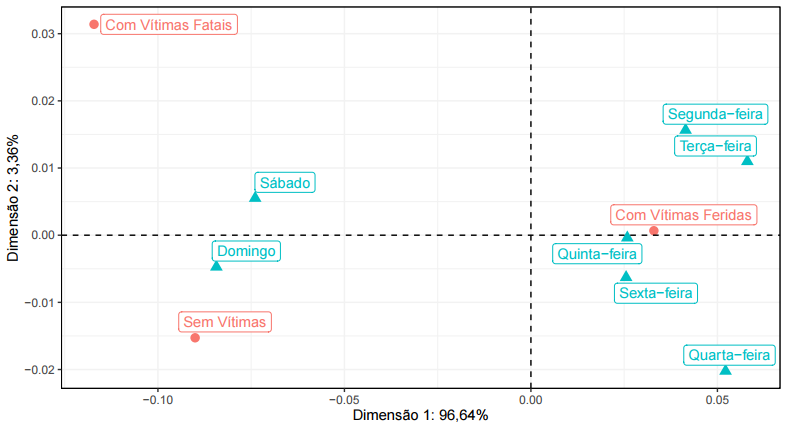The use of adjusted standardized residuals as an auxiliary measure in Simple Correspondence Analysis applied to accident data on federal highways in Brazil
Keywords:
Categorical data analysis, Bivariate analysis, ANACORAbstract
References
BARNETT, V.; LEWIS, T. Outliers in statistical data. 3. ed. Chichester: John Wiley & Sons, 1994.
BUSSAB, W. O.; MORETTIN, P. A., Estatística básica. 5ª edição. São Paulo: Saraiva, 2002.
CNT. Confederação Nacional do Transporte. Painel CNT de Consultas Dinâmicas dos Acidentes Rodoviários - 2020. Disponível em: https://www.cnt.org.br/painel-acidente. Acesso em: 06 set. 2021. 6 p.
CUNHA, J. Análise Multidimensional de Dados Categóricos: A aplicação das Análises de Correspondência Simples e Múltipla em Marketing e sua Integração com Técnicas de Análise de Dados Quantitativos. Rio Grande do Sul: UFRGS, 1997.
DASNT, Departamento de Análise em Saúde e Vigilância das Doenças Não Transmissíveis. Disponível em: https://shortest.link/dantpspaineis-de-monitoramentomortalidadecid10. Acesso em: 18 set. 2021.
FÁVERO, L. P.; BELFIORE, P. Manual de Análise de dados: estatística e modelagem multivariada com Excel®, SPSS® e Stata®. Rio de Janeiro: Elsevier, 2017.
GREENACRE, M.; BLASIUS, J. Multiple Correpondence Analysis and Related Methods. New York: Chapman & Hall/CRC, 2006.
HIRSFELD, H. O. A connection between correlation and contingency. Proceedings of the Cambridge Philosophical Society, p. 520, 524, 1935.
HUSSON,F.; JOSSE,J.; LE, S.; MAZET, J. FactoMineR: Multivariate Exploratory Data Analysis and Data Mining. R package version 2.4. 2020. Disponível em: https://CRAN.R-project.org/package=FactoMineR
HABERMAN, S. J. The analysis of residuals in cross-classified tables. Biometrics, v. 29, n. 1, p. 205 - 220, 1973.
INFANTOSI, A. F. C. ; GAMA DIAS COSTA, F. C.; ALMEIDA, R. M. V. R. Análise de correspondência: bases teóricas na interpretação de dados categóricos em ciências da saúde. Cadernos de Saúde Pública, n. 30(3), p.475 - 486, 2014.
JOHNSON, R. A. ; WICHERN, D. W. Applied Multivariate Statistical Analysis. New Jersey: Prentice Hall, 2007.
JUNIOR, G. T. B; BERTHO, A. C. S.; VEIGA, A. de C. A letalidade dos acidentes de trânsito nas rodovias federais brasileiras. Revista Brasileira de Estudos de População, 36, p. 1 - 22, 2019.
MINGOTI, S. A. Análise de dados através de métodos de estatística multivariada: Uma abordagem aplicada. Belo Horizonte, UFMG, 2005.
MIRANDA, R.; SILVA, W.P.; DUTT-ROSS, S. Identificação de fatores determinantes da severidade das lesões sofridas por pedestres nas rodovias federais brasileiras entre 2017 e 2019: Análise via regressão logística multinomial. Scientia Plena, v.17, n. 4, 2021. Disponível em: https://www.scientiaplena.org.br/sp/article/view/5897/2382
NAITO, S. D. N. P. Análise de Correspondências Generalizada. Dissertação (Mestrado em Bioestatística). Universidade de Lisboa, 2007.
PEREIRA, J. C. R. Análise de dados qualitativos: estratégias metodológicas para as ciências da saúde, humanas e sociais. 3. ed. São Paulo: Editora da Universidade de São Paulo, 2001.
PRF, Polícia Rodoviária Federal. Disponível em: https://arquivos.prf.gov.br/arquivos/index.php/s/n1T3lymvIdDOzzb. Acesso em: 06 set. 2021.
R CORE TEAM. R: A language and environment for statistical computing. R Foundation for Statistical Computing, Vienna, Austria. 2019. URL https://www.R-project.org/.
R CORE TEAM and contributors worldwide. stats: The R Stats Package. R package version 4.2.0. 2021. Disponível em: https://stat.ethz.ch/R-manual/R-devel/library/stats/html/00Index.html
ROQUIM, F. V; NAKAMURA, L. R.; RAMIRES, T. G.; LIMA, R. R. Regressão Logística: o que leva um acidente rodoviário a ser uma tragédia?. Sigmae, Alfenas, v.8, n,2, p. 19-28. 2019. Disponível em: https://publicacoes.unifal-mg.edu.br/revistas/index.php/sigmae/article/view/902/605
SHARPE, D. (2015). Your Chi-Square Test is Statistically Significant: Now What?. Practical Assessment, Research & Evaluation, 20(8). Disponível em: http://pareonline.net/getvn.asp?v=20&n=8
WORLD HEALTH ORGANIZATION (WHO). Global status report on road safety 2015. Geneva: WHO, 2015. Disponível em: https://shortest.link/whointviolenceinjuryprevention.

Downloads
Published
How to Cite
Issue
Section
License
Proposta de Política para Periódicos de Acesso Livre
Autores que publicam nesta revista concordam com os seguintes termos:
- Autores mantém os direitos autorais e concedem à revista o direito de primeira publicação, com o trabalho simultaneamente licenciado sob a Licença Creative Commons Attribution que permite o compartilhamento do trabalho com reconhecimento da autoria e publicação inicial nesta revista.
- Autores têm autorização para assumir contratos adicionais separadamente, para distribuição não-exclusiva da versão do trabalho publicada nesta revista (ex.: publicar em repositório institucional ou como capítulo de livro), com reconhecimento de autoria e publicação inicial nesta revista.
- Autores têm permissão e são estimulados a publicar e distribuir seu trabalho online (ex.: em repositórios institucionais ou na sua página pessoal) a qualquer ponto antes ou durante o processo editorial, já que isso pode gerar alterações produtivas, bem como aumentar o impacto e a citação do trabalho publicado (Veja O Efeito do Acesso Livre).
